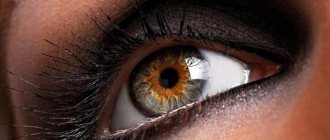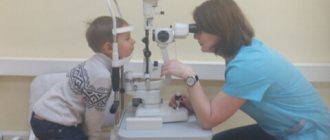A person looks at the world with two eyes, but sees only one picture. This happens due to the fact that the brain combines two images that are projected onto the central parts of the retinas into one visual image. As a result of the merging of two pictures, a three-dimensional image is created in the human mind, which forms the binocular vision system.
Thanks to this, you can feel volume, relief with your eyes and determine the exact location of objects in space. This is how the visual system of a healthy person works, but how cross-eyed people see can hardly be determined only by the movement of their eyes, which usually look in different directions. To do this, you need to take into account a number of factors that trigger the formation mechanism of this pathology.
Where does strabismus come from?
The causes of the pathology can be the following conditions and diseases:
- severe myopia – the patient sees well near, but poorly at a distance;
- severe hypermetropia - a person sees well in the distance, but poorly near;
- combination of severe hypermetropia and myopia;
- intrauterine development disorder;
- astigmatism is a violation of the shape of the eyeball, due to which a person incorrectly perceives the shape of objects;
- nervous overstrain, severe stress, emotional shock, especially occurring in childhood;
- pathologies of the central nervous system;
- difficulty passing blood through the vessels, which causes paralysis, paresis of the oculomotor muscle;
- experienced infections, especially those spreading to the organs of vision;
- chronic diseases of various organs (diabetes mellitus, atherosclerosis).
The patient may have a hereditary predisposition to the formation of strabismus, which appears when exposed to negative environmental factors.
Image formation
How does a person with strabismus see? Such people do not have stereoscopic vision, so they are not able to perceive surrounding objects in three dimensions. This is due to the fact that when looking at an object, the image reflected from it onto different parts of the retinas.
Therefore, the visual analyzer of the central nervous system is not able to merge 2 pictures into a single whole, so two images are formed. The brain protests against this optical discomfort by turning on a defense mechanism that ignores the image of the defective eye.
It should be taken into account that with a long course of the disease, a person experiences a functional decrease in vision or amblyopia. In this case, one eye sees almost nothing. They call him lazy because he disconnects from the visual process. Considering the mechanism of pathology development, how does a person with strabismus see? Such people look with monocular vision; they cannot perceive it three-dimensionally and fully.
Development mechanism
When considering the topic of how a person with strabismus sees, you should familiarize yourself with the principle of development of this pathology. Each organ of vision has 6 muscles. With their help, synchronous movement of the eyeballs is ensured. When changing the direction of gaze, both eyes must perform a simultaneous and unidirectional movement.
As a result, the gaze will be on 1 point of the object in question. And when the coordinated work of the visual muscles is disrupted, the eyes move and look in different directions. This pathology is called strabismus. But in medicine it is called strabismus or heterotropia.
Strabismus is an ophthalmological disease that can be diagnosed without a doctor. Many people attribute the pathology to an aesthetic defect, without considering that this leads to functional visual impairment. The reasons for the failure of the synchronous functioning of the visual muscles are different, but they determine the type and nature of the disease. How a person with and without strabismus sees is noticeably different. The manifestations of the pathology are described below.
What does physiognomy say?
If you believe this ancient art, then slanted eyes are considered the most ideal. Their owners are quite cheerful, optimistic and courageous people, capable of even taking an adventure. A lively mind and lightning speed of thought allow them to easily find a way out of the most difficult situations.
Physiognomy also states that owners of slanted eyes are emotional people who are able to enjoy life. However, their emotionality can play a cruel joke on them, as their mood can change in a matter of seconds. A complacent attitude can immediately turn into an unreasonable outburst of anger. Unfortunately, this often turns others against them. For the same reason, they do not always have successful love and friendship relationships - they are able to quickly and groundlessly break off any connection.
The principle of treatment of strabismus
Strabismus is a disease that changes the visual perception of the world, worsens the quality of life, limits performance and often causes psychological discomfort. Unfortunately, this disease never goes away on its own, and therefore it must be treated. The scheme for correcting strabismus is selected by the ophthalmologist based on the examination and taking into account the patient’s age, the reasons for the development of the pathology and the presence of a lazy eye. But regardless of the type of strabismus, the principle of its treatment is based on solving three important problems:
- restoration of vision of a lazy eye;
- correcting an aesthetic defect by establishing the symmetry of the two pupils;
- stimulation of the development of three-dimensional vision.
Despite the fact that modern technologies today can completely correct any degree of strabismus, this process is very long, labor-intensive, requiring the patient to comply with a number of medical prescriptions and perform special visual exercises.
Therapy or surgery
Conservative treatment is usually prescribed for children no older than 7 years. The primary goal of the therapeutic method is optical correction of existing visual deviations. That is, the child is prescribed glasses that he must wear at all times. If amblyopia is present, pleoptic treatment is prescribed. To do this, one lens of the glasses must be sealed, and the glass is left open for the lazy eye. It is on him that the entire visual and functional load is placed, forcing weakened muscles to work. After optical correction of vision and restoration of the symmetry of the eye pupils, it is necessary to begin the process of restoring and strengthening stereoscopic vision. For this purpose, hardware methods, optical procedures and specially developed computer programs are used.
If the therapy does not bring the desired result, then the small patient is indicated for surgery to weaken the strong or strengthen the atrophied extraocular muscle. Due to his young age, the child has not yet undergone irreversible functional changes in the retina and he has every chance to completely cure amblyopia and restore stereoscopic vision.
It is important to take into account that if an operation is performed on an adult whose disease developed in childhood, the result of treatment will only be the elimination of a cosmetic defect. Unfortunately, it is impossible to awaken a sleeping eye and restore three-dimensional vision to an adult patient, since irreversible changes have already occurred in his central nervous system
But people who have developed strabismus as a result of injury can, with the help of surgery, return not only symmetry to their eyes, but also completely restore the binocular vision system and get rid of exhausting double vision.
Why do the eyes start looking in different directions?
Unfortunately, strabismus affects both children and adults equally. Moreover, the reasons for its development can be both congenital and acquired, and the most common of them include:
- anomalies of intrauterine development of the fetus;
- moderate and high degree optical impairment of visual acuity;
- neurological problems;
- complications after infectious diseases;
- abnormalities of the extraocular muscles;
- stress and mental disorders;
- serious head injuries;
- inadequate load on the visual system:
- rapid deterioration of visual acuity in one eye.
If the eye begins to squint even a little, then this is the main sign of the development of strabismus. In a child, parents should be the first to notice such a deviation. They are the ones who are obliged to immediately seek advice from an ophthalmologist, who at an early stage will help stop the development of the disease and correct the existing visual and functional defect.
In adults, strabismus can have a different nature of origin. If the illness lasts from childhood, this means that the person is accustomed to seeing the world as flat, and, apart from a cosmetic defect, this illness no longer bothers him. If the cause of the deviation is external factors, then the main sign of such strabismus is no longer just an aesthetic defect. The thing is that in adults the adaptive properties of the brain are reduced and therefore it cannot turn off the image of the diseased eye. As a result, such patients begin to suffer from double vision, dizziness and constant headaches. In search of a convenient viewing angle, a person begins to squint one eye and constantly tilt his head to one side.
Forms of origin
The form of the pathology is friendly and paralytic. The first type develops from poor heredity, anomalies in the structure of the visual organ. Most often it appears in childhood. In this situation, the eyes squint alternately, the angle of deviation from the center of the retinal axis of the eyes is almost the same. It turns out that the movement of the eyeballs is completely preserved.
If a person looks at an object with a sideways eye, then a normal one will turn at the same distance. In this case, there is no double vision, since they immediately have amblyopia.
Paralytic disease can be congenital or acquired. It appears from paralysis of the eye muscles or from disruption of the optic nerve. Pathology occurs due to injuries, congenital anomalies, infections, tumors, and intoxication of the body.
In this case, the diseased eye does not move completely or partially. The load will be on the healthy visual organ, which needs to squint strongly and deviate at a large angle to cover the required viewing angle. Atypical strabismus is a specific disease, as it is usually observed in people with Down and Brown syndrome.
Causes of the disease
As we have already said, strabismus can be congenital or acquired. Adults, as a rule, acquire strabismus. A small percentage comes from neglected, untreated strabismus from childhood. In this case, it is only possible to eliminate the cosmetic defect. In most cases, childhood strabismus develops and is cured before the age of 14.
Causes of congenital strabismus:
- Pathologies of fetal development.
- Congenital malformations of the oculomotor muscles.
- Premature birth of a premature baby.
- Down's disease, cerebral palsy, hydrocephalus.
- Congenital eye diseases, cataracts, glaucoma, refractive errors.
- Diseases of the mother, the effect of a harmful environment on her body during gestation. These could be medications, radiation, trauma, intoxication.
- Measles, scarlet fever, diphtheria, influenza, ARVI.
Causes of strabismus in adults:
- Impaired refraction of the eye, the presence of farsightedness, astigmatism or myopia. When one eye sees worse than the other, and this is not corrected by optics.
- After a head injury, due to damage to the structures of the visual apparatus or blood vessels, tissues, and nerve connections that are disrupted during brain injury.
- The simplest possible cause of strabismus is prolonged visual strain. For example, looking at a mobile phone screen for a long time, which ultimately leads to overstrain and hypertonicity of the oculomotor muscles.
- Optic nerve atrophy.
- Multiple sclerosis.
- After a stroke, depending on the location of the hemorrhage, paralysis or weakness of the extraocular muscles may occur.
- Eye pathologies such as cataracts, glaucoma, eyesores, malignant neoplasms.
- Against the background of psychosomatics: nervousness, anxiety, fear, mental disorders.
- Retinal detachment.
- High intracranial pressure (ICP).
- Infectious diseases of the eyes and membranes of the brain.
- Rheumatoid arthritis.
What is strabismus?
In order to understand how cross-eyed people see, it is necessary to determine not only the causes of the development of the disease, but also to classify the disease according to all the characteristics that form it, which can be divided:
- by type: hidden, imaginary and true;
- by form: friendly, paralytic and atypical;
- by type: convergent, divergent, vertical and mixed;
- according to eye involvement: unilateral and intermittent;
The complex structural and functional structure of the visual system determines the presence of a large number of all kinds and forms of strabismus. The success of conservative and especially surgical treatment of such a deviation largely depends on their correct classification.
Forms of origin of strabismus
The form of strabismus is concomitant and paralytic. Poor heredity, abnormalities in the structure of the organ of vision and childhood are often the main reasons for the development of concomitant strabismus. In this case, the eyes squint alternately, and the angle of deviation from the central axis of the retina is approximately the same in each eye. That is, the movement of the eyeballs with this form of deviation is preserved in full. If a person focuses on an object with a squinting eye, then the normal organ of vision will turn the same distance. In other words, parity of the primary and secondary deflection angle is formed. Children with this form of strabismus never experience double vision, since they immediately develop amblyopia.
Paralytic strabismus can be either a congenital pathology or an acquired one. It is formed as a result of paralysis of the eye muscles or as a result of disruption of the optic nerve. The cause of the development of such pathologies can be injuries, congenital anomalies, infections, tumors and even general intoxication of the body. Typically, with this form of deviation, the affected eye does not move at all or partially. The entire functional load falls entirely on the healthy organ of vision, which, in order to cover the desired viewing angle, has to squint strongly and deviate at a large angle.
Atypical strabismus refers to a specific disease, as it occurs mainly in people with Down syndrome, Brown syndrome, and DVD diagnosis.
Types of strabismus
If a person suffers from various visual acuity disorders, then a certain part of the oculomotor muscles begins to perform increased movements to find the desired visual focus when viewing a close or distant object. This is precisely the main reason for the development of a certain type of visual deviation. Thus, strabismus occurs:
- the pupil is turned towards the bridge of the nose - converging;
- the pupil is turned towards the temple - divergent;
- the pupil is raised up or down – vertical;
- a combination of all of the above types - mixed.
Each type of pathology is divided into monocular and alternating strabismus. In the first case, only one eye is involved in the pathological process, and in the second, both visual organs are squinted alternately.
What is strabismus
Strabismus, or, as it is scientifically called, strabismus, is a violation of the synchronicity of the eyes. This is mainly a childhood disease, but also occurs in adults. The age of the patient plays a huge role in the success of treatment. The longer strabismus is not treated, the worse the recovery of binocular vision, even after surgery.
12 extraocular muscles are involved in the movement of both eyeballs, 6 for each eye. Each muscle is responsible for turning the eye in one direction or another, up or down. At birth they are not synchronized; the child learns to look in the process of acquiring visual experience. Therefore, strabismus up to 6 months is natural and considered normal.
As the brain grows older, it learns to perfectly match the images received from the right and left eyes. Thanks to this, binocular (three-dimensional, three-dimensional) vision is formed. It is binocular vision that is responsible for hundredths of degrees of the ideal location of the eyeballs. This quality is acquired, that is, in the absence of a double visual image during the formation of vision, a person will never learn to see correctly again.
Mild strabismus is hardly noticeable, is usually detected by chance, and is easy to eliminate. Severe advanced strabismus is often associated with disturbances in the optic nerves in the cerebral cortex, which is not always treatable.
If the image quality in one of the eyes is impaired, the brain switches to the second eye, which sees more clearly. In this case, the lagging eye begins to be suppressed, squinted, or completely excluded from the vision process. This is how amblyopia, or “lazy eye,” develops.
With amblyopia, the visually impaired eye completely loses its functions over time, which leads to blindness even after correction. There is no cure for adult amblyopia. The quality of vision can only be fixed, stopping the progression of adult amblyopia at the level at which treatment began.
The video below shows more clearly what strabismus is:
Read more about the features of childhood strabismus here.
How do cross-eyed people see?
In order to clearly see an image with a healthy visual apparatus, the eye needs to fix it in a certain visual zone on the retina. This is called focusing the image.
Ideal focusing is achieved at a certain point where the axes of both eyes intersect, which gives the same, clear, three-dimensional image. We get two images of the same object on both sides. This information is transformed in the brain and gives us an understanding of the thickness, depth, and volume of an object.
The world a person sees with strabismus is flat. The dominant eye is fixed correctly on the object, while the squinting eye gives a completely different picture, from a different angle, without clarity, as if in fog. Therefore, it is suppressed and only one image remains - a two-dimensional one.
In the initial stages of strabismus, with binocular vision still preserved, objects appear double. At first, the borders and outlines become double, and over time, as the angle of strabismus increases, the entire image becomes double. Gradually, double vision is suppressed by the brain and turns into a flat image.
Is strabismus inherited?
Many parents ask: “Can strabismus be inherited from the father or mother?” Definitely not, there may be a genetic predisposition to this disease, for example, weakness of the extraocular muscles or the structure of the eyeball, but the pathology itself is not transmitted.
All congenital types of strabismus are intrauterine problems with the development of the fetus, under the influence of some external factors. In its pure form, strabismus is not formed and is not transmitted.
Also, the second option for predisposition to strabismus may be inherited eye diseases, which in the future will cause the development of strabismus. The only thing worth paying attention to if parents suffer from strabismus is early prevention and regular examination of the child by an ophthalmologist.
Can the disease appear in adulthood?
You can acquire strabismus at any age, as it is a complication of many eye diseases, visual strain, injuries, and general systemic diseases of the body.
Binocular vision is formed before the age of 14. If strabismus is not treated during this period, there is nothing that can be done to help it at an older age. The quality of vision is not corrected in any way, and the operation will only help temporarily eliminate the defect of deviation of the eyes from the point of fixation.
If strabismus develops in an adult against the background of normal vision formation in childhood, then timely treatment will restore the sharpness and external aesthetics of the visual apparatus.
Can the disease go away on its own?
Depends on the reason that provokes it. Eliminate the cause and strabismus goes away. There are different cases, there is hidden strabismus, which, due to binocular vision, is not distinguished by a clear violation of the visual axes. Wearing corrective optics in the early stages completely eliminates the external defect.
The development of strabismus is not an independent disease; most often it is a consequence of another disease. Therefore, people with strabismus treat asynchrony of the eyeballs only as one of the stages of the general treatment of another “main” disease. Strabismus does not appear or go away on its own.
Diagnostics
Assessment of the visual function of a patient with suspected strabismus is carried out in several stages:
- Interview with the patient or his parents. There are complaints of headaches, decreased vision function, deviation of one eye from the normal axis.
- General inspection. If the strabismus is hidden, no symptoms will be detected. For other forms of strabismus or amblyopia, the doctor will be able to determine the symptoms of the pathology using a visual examination.
- Assessment of visual acuity using diagnostic tables. The more lines the patient sees in them separately with the right and left eyes, the better his visual acuity. If a person has developed amblyopia, one eye will be completely blind.
- The use of specialized equipment to determine the angle of strabismus.
- Examination by a neurologist. It is necessary for those patients in whom strabismus is caused by pathology of the central nervous system.
Based on the data obtained, the doctor makes a reliable diagnosis, and only then treatment begins.
Diagnosis of strabismus
Correct diagnosis is the basis for successful treatment, and strabismus is no exception. The thing is that with the same external symptoms, this pathology is replete with a variety of all kinds. Therefore, before starting treatment, the doctor, based on the patient’s complaints, must determine the cause of strabismus and be sure to conduct a full ophthalmological examination of the visual system. It is carried out on high-precision diagnostic equipment, using special computer programs, tables, mirrors and usually consists of the following procedures:
- general vision examination;
- complete refraction of the visual system;
- measuring the strabismus angle using different methods;
- checking the synchronous operation of both eyes;
- conducting a stereoscopic vision test;
- study of pupil mobility in all directions.
If strabismus has developed as a result of neurological abnormalities, the patient is given a consultation with a neurologist, a computed tomography scan is performed, and an x-ray is taken.
What do they see?
So how do nearsighted people see the world? This question is not easy to answer. Imagine that you cannot concentrate on an object and see it blurry, noticing only its outlines. A similar effect can be compared to setting the camera on a smartphone. After all, at this moment, at first the picture turns out to be soapy or cloudy. Also, when watching a film, the character in the foreground is clearly visible, but the background is blurred, and the viewer can only discern the silhouettes of objects located behind the character.
View gallery
This is exactly how myopic people see the world around them without the use of glasses. Well, if the patient puts on glasses prescribed by his doctor, he will improve his vision and be able to see everything around him in its natural form.
This effect is achieved using optical lenses placed in the frame. They transmit light rays through themselves in the correct form. As a result, the resulting image appears directly on the retina.
In addition, optical lenses cause the eye muscles to tense, which is why the patient begins to see better. Don't want to suffer from vision loss? Follow the basic rules for preserving it and contact your ophthalmologist on time.
Symptoms and signs of strabismus
The deviation, if it is not congenital, often appears and develops at an early age. It does not always manifest as a visually noticeable disorder. According to its origin, heterotropia can be of two types, paralytic and concomitant, it depends on the etiology.
Friendly strabismus
With this type of strabismus, the following symptoms appear:
three-dimensional vision impairment;
both eyes can squint in turn;
if the gaze stops at a static object, one of the eyes deviates;
ametropia or anisometropia are present;
the mobility of the eyeballs is free and without disturbances;
the deflection angles are equal to each other (primary and secondary);
when looking at objects, double vision does not occur;
a squinting eye may see worse.
There are several forms of such strabismus. According to the classification, they are divided into non-accommodative, accommodative or partially accommodative.
Paralytic strabismus
This type of heterotopia occurs due to damage to the eye muscles. As a rule, only one eye squints. The signs of paralytic strabismus are:
three-dimensional vision is impaired;
periodically feel dizzy;
diplopia (split objects) is observed;
the head tilts towards the squinting eye;
The secondary deflection angle is greater than the primary one.
The main feature of paralytic strabismus is that the movement of the diseased eyeball in the direction of contraction of the affected muscle is limited.
Classification of types of strabismus
The classification of strabismus (strabismus) is varied and depends on the form, type, stage, and clinical picture of the disease. All types of strabismus are divided primarily into two large groups: acquired or congenital strabismus. A pathology that appears in the first 6 months of a baby’s life is considered congenital; the disease at an older age or in an adult is acquired. Next comes a more detailed classification.
Types of strabismus:
1. Explicit (visible) strabismus occurs:
- horizontal:
- convergent (esotropia) - when the squinting eye tends to the bridge of the nose;
- divergent (exotropia) - when the squinting eye goes to the temple;
- vertical:
- hypertropia - upward deviation of the squinting eye;
- hypotropia - downward deviation of the squinting eye;
- mixed.
2. Depending on the prevalence of the pathology:
- alternating - when both eyes are squinted, but in turn, the person looks with either the right or the left eye;
- monolateral - always squints the same eye.
3. By the nature of the stability of manifestations:
- permanent;
- fickle.
4. According to the nature of the clinical picture:
- heterophoria – hidden strabismus;
- compensatory – internal strabismus is detected at a doctor’s appointment;
- subcompensatory – slight strabismus;
- decompensated.
5. Due to the occurrence:
- friendly:
- accommodative (refractive) strabismus - causes: farsightedness, myopia, astigmatism;
- partially accommodative - in addition to refraction, there are problems with muscles;
- non-accommodative - muscle pathology;
- paralytic (monolateral) - paralysis of all or several extraocular muscles.
Exercises for strabismus
I would like to note that treating strabismus without surgery is a long journey of several months and even years. But with the right approach and following all the doctor’s instructions, you can completely get rid of this disease. The most effective thing is to strengthen the eye muscles with the help of special exercises.
- Stand up straight and extend your hand in front of you. Focus on one finger. Then you need to slowly bring your finger to your face, and then slowly move it back. The head is motionless, only the pupils follow one point. After that, move your finger left, right, up and down. Repeat each movement 5 times.
- Stand by the window and stick a picture with bright colors on the glass. Look at the picture at arm's length. Then look at the antenna of a neighboring house or any other object in the distance. After 30 seconds, look at the picture again. This way you focus your vision on far and near objects, this is an excellent exercise for training the eye muscles. Separately, the exercise can be done with one sore eye.
- The next exercise is figure eight. You need to draw a huge figure eight in front of you with your pupils. Movements should be smooth, try not to cut corners. After this, try to make an inverted figure eight - an infinity sign. Do the exercise slowly and carefully.
- Have you been to the tennis court? This is a great place to train your eyesight. Constantly changing the position of the ball forces you to move your eyes from side to side. Instead of tennis, any ball games are suitable - volleyball or basketball. You can watch the game or participate in it - it is equally beneficial for your eyesight.
- Train the eye that squints. Cover the healthy eye with a bandage and try to look with the affected eye in the direction where it does not want to turn. Look at a bright object with at least peripheral vision, train an undeveloped muscle.
- If you encounter strabismus in a young child, he will not be able to consciously perform eye exercises. Therefore, show him colorful images that should be placed to the right and left of him. Constantly ask, “Where is the bird?”, “Where is the ant?”, so that the child involuntarily trains his eye muscles by looking up and down.
Patient daily work will help restore the sore eye. Regular exercise will make you not only healthy, but also a confident person. This is evidenced by the huge number of positive reviews from people who have overcome this disease. Be healthy and happy!
Symptoms
Concomitant strabismus is characterized by the following symptoms:
In paralytic strabismus, only one eye is constantly squinting. The main symptoms of such strabismus are:
Sometimes strabismus does not appear immediately, but, for example, in the late afternoon, when the child is active. The defect can appear periodically, and parents, as a rule, think that the child is playing around and sometimes do not pay attention to it.
Strabismus requires immediate correction. Results depend on the timeliness of treatment.
Strabismus in a child or adult can be determined during an ophthalmological examination by a doctor. Diagnostics include:
In the process of examining children, the ophthalmologist first conducts a survey of parents in order to determine when and under what circumstances strabismus was noticed, and how it manifested itself: suddenly or over a certain period of time. Congenital pathology is usually associated with fetal injuries during childbirth or diseases of the central nervous system. The acquired form is associated with refractive errors.
Strabismus can be congenital or acquired. In the first case, the cause of strabismus is a hereditary predisposition, congenital abnormalities in the development of the extraocular muscles, or diseases of the mother during pregnancy.
Among the causes of acquired strabismus, diseases of the central nervous system are most often called; injuries, both physical and mental; deterioration of vision in one eye; past infectious diseases, which are a common cause of strabismus in children.
In most cases, the cause of all types of myopic astigmatism is a hereditary predisposition.
There are two main reasons for the development of this defect: • Short eyeball. Often heredity is to blame. • Poor optical system of the eye (due to insufficient refraction of light). Elderly people suffer due to age-related changes in the body.
It may be a combination of these two reasons that subsequently causes visual disturbance. To identify the symptoms, one name of the disease is enough; many people believe that with farsightedness a person sees poorly near, but there may also be problems with distant vision.
The main symptoms of the defect:• Impaired visual concentration near. • Poor distance vision. • Frequent inflammatory eye problems. • Severe and rapid fatigue when reading. • Children may suffer from strabismus.
It is important to understand eye astigmatism and what it is, especially if there have been cases of problems with the optical system of the eyes in your family. It is also important to remember that farsightedness, like nearsightedness, is a common diagnosis for astigmatism.
Eye astigmatism, the treatment of which is a lengthy procedure, can completely deprive you of your vision if treated incorrectly or untimely.
Like any other disease, astigmatism has causes:
- Genetic predisposition.
- Improper development of the lens.
- Complication after eye surgery.
- Injury.
- Diabetes.
- High blood pressure.
Strabismus in children is one of the few pathologies that can be recognized without the help of a specialist. Strabismus (heterotropism, strabismus) is characterized by asymmetry of both or one eye relative to the central axis and the inability to focus on a specific object.
The disease is most common in children 2–3 years old, since at this age the friendly functioning of the eyes is formed. Strabismus often occurs in newborns, but it is temporary and goes away.
Strabismus is not only a cosmetic defect, but also a dangerous pathology. A squinting eye sees worse and develops poorly. If strabismus is not corrected before age 7, the strain on the healthy eye will increase and vision will deteriorate.
Strabismus, heterotropia, stabismus
Children should not hang toys close to them, watch TV all day long, play computer games, or spend long periods of time in front of a tablet or phone screen. You need to walk more in the fresh air, play physical games, get stronger, and generally lead a healthy lifestyle.
By following simple recommendations, you can avoid this eye disease. Finding out everything about vision and how to save it is not difficult if you have the Internet.
Stages of the judicial procedure
The judicial procedure for ending a marriage includes several stages.
Preparing a claim and filing it
When drawing up a claim, you must be guided by the form established by Art. 131-132 Code of Civil Procedure of the Russian Federation. After preparing the claim, originals or copies of the necessary documents are attached to it. After paying the state fee, the statement of claim is sent to the court in person or by mail.
Preparing for a court hearing and scheduling it
If the claim was drawn up correctly and filed in the appropriate court, after accepting the documents for proceedings, the judge conducts appropriate preparation, during which:
- all participants in the case receive copies of the ruling on the preparation of the claim and the documents attached to it for consideration;
- on his own initiative or at the request of the parties, makes the necessary motions or requests that will help obtain additional evidence;
- attracts, if necessary, representatives of guardianship authorities and third parties to participate in the court hearing.
Notification of participants in the court session
After the judge makes a ruling, the secretary sends summonses to all participants at the addresses indicated in the statement of claim. They can be notified by SMS notification or by phone numbers specified in the claim. After the call, a document about the progress of the conversation is left.
Time limits for consideration of a divorce claim
The magistrate must consider the claim filed by the parties in no more than a month. If the second spouse decides to appeal the decision, it comes into force in another month.
When dissolving a marriage in a district court, along with deciding the issue of division of property and the fate of children, the law allots 2 months. If the district judge deems it necessary, in order to preserve the family, he can give the spouses time for reconciliation, suspending the consideration of the claim for a maximum of 3 months. The overall review time may also be delayed due to an examination or illness of one of the parties. In this case, the judge issues a suspension order.
Court session
Consideration of a claim for divorce takes place in accordance with the provisions of Chapter. 15 Code of Civil Procedure of the Russian Federation:
- first, the court secretary announces the names of the persons present at the court hearing;
- after this, the judge explains to the plaintiff, defendant and other participants in the case their immediate rights and obligations, and then accepts the existing petitions for consideration;
- then the judge listens to the opinions of the parties and third parties and clarifies what requirements they make of each other;
- after determining the procedure for examining the documentary and other evidence available in court, the interrogation of witnesses begins;
- Having found out all the circumstances of the case, the judge schedules the final statements of the parties (debate). First they listen to the plaintiff, then the defendant and other interested parties;
- having retired to the deliberation room, the judge makes a decision there;
- after returning, the court verdict is announced in the presence of all participants.
Note!
If during the debate the plaintiff or defendant provided new evidence that was previously impossible to present to the court, then the judge has the right to resume proceedings in the case.











